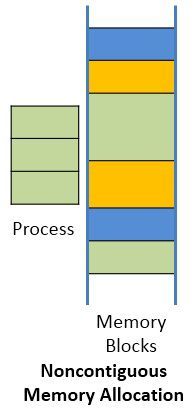Noncontiguous memory allocation techniques in OS
The Non-contiguous memory allocation allows a process to acquire the several memory blocks at the different location in the memory according to its requirement.
The noncontiguous memory allocation also reduces the memory wastage caused due to internal and external fragmentation.
As it utilizes the memory holes, created during internal and external fragmentation.

The noncontiguous memory allocation has an advantage of reducing memory wastage but, but it increases the overheads of address translation.
As the parts of the process are placed in a different location in memory, it slows the execution of the memory because time is consumed in address translation.
Here, the operating system needs to maintain the table for each process which contains the base address of the each block which is acquired by the process in memory space.
There are some ways used to in noncontiguous memory allocation techniques:-
1.paging
2.segmentation
Conclusion:-
Conclusion:-
Contiguous memory allocation does not create any overheads and fastens the execution speed of the process but increases memory wastage. In turn noncontiguous memory allocation creates overheads of address translation, reduces execution speed of a process but, increases memory utilization. So there are pros and cons of both allocation methods.
Thank you viewers..
This is published by soumy Sinha...

Comments
Post a Comment